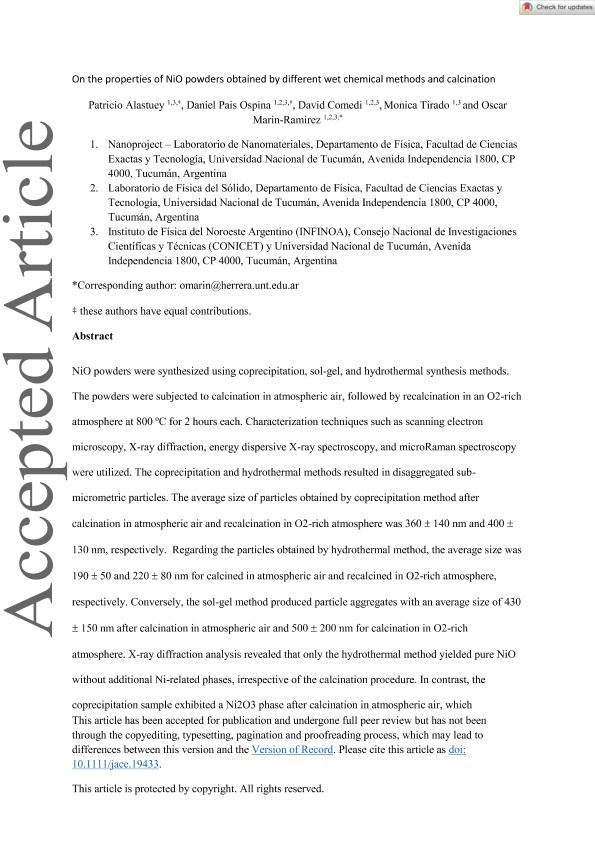Mostrar el registro sencillo del ítem
dc.contributor.author
Alastuey, Patricio

dc.contributor.author
Pais Ospina, Daniel Humberto

dc.contributor.author
Comedi, David Mario

dc.contributor.author
Tirado, Monica Cecilia

dc.contributor.author
Marín Ramírez, Oscar Alonso

dc.date.available
2024-01-18T14:02:31Z
dc.date.issued
2023-09
dc.identifier.citation
Alastuey, Patricio; Pais Ospina, Daniel Humberto; Comedi, David Mario; Tirado, Monica Cecilia; Marín Ramírez, Oscar Alonso; On the properties of NiO powders obtained by different wet chemical methods and calcination; Wiley Blackwell Publishing, Inc; Journal of the American Ceramic Society; 107; 1; 9-2023; 92-106
dc.identifier.issn
0002-7820
dc.identifier.uri
http://hdl.handle.net/11336/224116
dc.description.abstract
NiO powders were synthesized using coprecipitation, sol-gel, and hydrothermal synthesis methods. The powders were subjected to calcination in atmospheric air, followed by recalcination in an O2-rich atmosphere at 800°C for 2 h each. Characterization techniques, such as scanning electron microscopy, X-ray diffraction, energy dispersive X-ray spectroscopy, and microRaman spectroscopy, were utilized. The coprecipitation and hydrothermal methods resulted in disaggregated submicrometric particles. The average size of particles obtained by the coprecipitation method after calcination in atmospheric air and recalcination in an O2-rich atmosphere was 360 ± 140 nm and 400 ± 130 nm, respectively. Regarding the particles obtained by the hydrothermal method, the average size was 190 ± 50 and 220 ± 80 nm for calcined in atmospheric air and recalcined in O2-rich atmosphere, respectively. Conversely, the sol-gel method produced particle aggregates with an average size of 430 ± 150 nm after calcination in atmospheric air and 500 ± 200 nm for calcination in an O2-rich atmosphere. X-ray diffraction analysis revealed that only the hydrothermal method yielded pure NiO without additional Ni-related phases, irrespective of the calcination procedure. In contrast, the coprecipitation sample exhibited a Ni2O3 phase after calcination in atmospheric air, which disappeared after recalcination in an O2-rich atmosphere. The sol-gel-derived sample maintained a Ni phase after both calcination processes. Analysis of the crystallite size demonstrated an increase after recalcination in an O2-rich atmosphere for the hydrothermal and sol-gel-derived samples, while a decrease was observed for the coprecipitation-derived sample. Raman spectra exhibited defect-enabled first-order forbidden phonon modes that were sensitive to the synthesis route. The two magnon phonon modes also demonstrated dependency on the route, indicating variations in defect structures. Photocatalytic evaluation using methylene blue degradation in aqueous solutions indicated better performance for the powders recalcined in an O2-rich atmosphere.
dc.format
application/pdf
dc.language.iso
eng
dc.publisher
Wiley Blackwell Publishing, Inc

dc.rights
info:eu-repo/semantics/openAccess
dc.rights.uri
https://creativecommons.org/licenses/by-nc-sa/2.5/ar/
dc.subject
NIO
dc.subject
PHOTOCATALYSIS
dc.subject
RAMAN SPECTROSCOPY
dc.subject
TWO MAGNON PHONON MODES
dc.subject
WET CHEMICAL SYNTHESIS
dc.subject
X-RAY DIFFRACTION
dc.subject.classification
Otras Ciencias Químicas

dc.subject.classification
Ciencias Químicas

dc.subject.classification
CIENCIAS NATURALES Y EXACTAS

dc.title
On the properties of NiO powders obtained by different wet chemical methods and calcination
dc.type
info:eu-repo/semantics/article
dc.type
info:ar-repo/semantics/artículo
dc.type
info:eu-repo/semantics/publishedVersion
dc.date.updated
2024-01-16T14:08:41Z
dc.journal.volume
107
dc.journal.number
1
dc.journal.pagination
92-106
dc.journal.pais
Reino Unido

dc.journal.ciudad
Londres
dc.description.fil
Fil: Alastuey, Patricio. Universidad Nacional de Tucumán. Instituto de Física del Noroeste Argentino. - Consejo Nacional de Investigaciones Científicas y Técnicas. Centro Científico Tecnológico Conicet Noa Sur. Instituto de Física del Noroeste Argentino; Argentina
dc.description.fil
Fil: Pais Ospina, Daniel Humberto. Universidad Nacional de Tucumán. Instituto de Física del Noroeste Argentino. - Consejo Nacional de Investigaciones Científicas y Técnicas. Centro Científico Tecnológico Conicet Noa Sur. Instituto de Física del Noroeste Argentino; Argentina
dc.description.fil
Fil: Comedi, David Mario. Universidad Nacional de Tucumán. Instituto de Física del Noroeste Argentino. - Consejo Nacional de Investigaciones Científicas y Técnicas. Centro Científico Tecnológico Conicet Noa Sur. Instituto de Física del Noroeste Argentino; Argentina
dc.description.fil
Fil: Tirado, Monica Cecilia. Universidad Nacional de Tucumán. Instituto de Física del Noroeste Argentino. - Consejo Nacional de Investigaciones Científicas y Técnicas. Centro Científico Tecnológico Conicet Noa Sur. Instituto de Física del Noroeste Argentino; Argentina
dc.description.fil
Fil: Marín Ramírez, Oscar Alonso. Universidad Nacional de Tucumán. Instituto de Física del Noroeste Argentino. - Consejo Nacional de Investigaciones Científicas y Técnicas. Centro Científico Tecnológico Conicet Noa Sur. Instituto de Física del Noroeste Argentino; Argentina
dc.journal.title
Journal of the American Ceramic Society

dc.relation.alternativeid
info:eu-repo/semantics/altIdentifier/url/https://ceramics.onlinelibrary.wiley.com/doi/10.1111/jace.19433
dc.relation.alternativeid
info:eu-repo/semantics/altIdentifier/doi/http://dx.doi.org/10.1111/jace.19433
Archivos asociados
